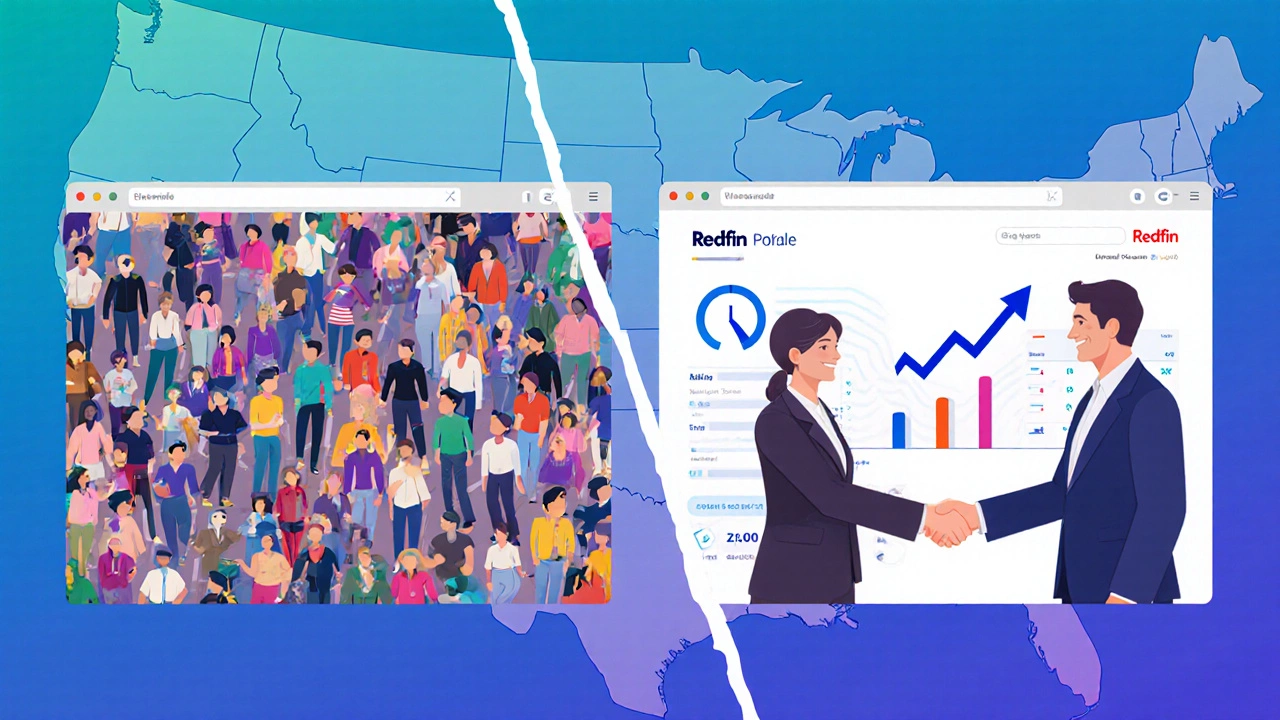Who Is Zillow's Biggest Competitor? An In‑Depth Look at the Real‑Estate Marketplace Battle

Real Estate Platform Comparison Tool
Zillow
170 million monthly visitors
Avg. listing price: $415,000
Conversion rate: 9.1%
Redfin
68 million monthly visitors
Avg. listing price: $398,000
Conversion rate: 12.4%
| Metric | Zillow | Redfin |
|---|---|---|
| Monthly visitors | 170 million | 68 million |
| Average home-sale price listed | $415,000 | $398,000 |
| Lead conversion rate | 9.1% | 12.4% |
| Mobile-app rating (iOS/Android) | 4.5 / 4.4 | 4.7 / 4.6 |
| Commission model for agents | Traditional 2.5-3% split | 1% + $5,000 fee |
| Revenue (FY 2024) | $3.1 billion | $1.1 billion |
Zillow
- Massive brand recognition
- Largest audience reach
- Strong advertising network
- Zestimate valuation tool
Redfin
- Higher conversion rate
- Agent-friendly commission model
- More accurate home-value estimates
- Better mobile experience
When you type "homes for sale" into a search engine, Zillow almost always appears on the first page. That dominance makes the question "who is the biggest competitor of Zillow?" more than a trivia item - it’s a real decision point for buyers, sellers, and agents who rely on online tools to move property. This article breaks down the major players, explains why one of them consistently edges out the rest, and gives you a clear way to pick the platform that fits your goals.
Quick Takeaways
- Zillow competitor that most analysts point to is Redfin, a publicly traded brokerage that blends listings with a strong tech stack.
- Zillow still leads in raw traffic and brand awareness, but Redfin outperforms Zillow on conversion‑rate metrics and agent‑generated revenue.
- Other platforms - Realtor.com, Opendoor, Compass, eXp Realty, and Homes.com - each own niche strengths that can make them the right choice for specific use cases.
- Key comparison points are monthly visitors, average home‑sale price of listings, mobile‑app rating, and commission structure for agents.
- Choosing a platform isn’t a one‑size‑fits‑all; weigh your priorities (price transparency, local agent network, data depth) against each site’s core offering.
Understanding Zillow's Market Position
Zillow was founded in 2006 and quickly grew into the go‑to online real‑estate marketplace in the United States. Its core strengths lie in massive data aggregation - the "Zestimate" valuation engine, auser‑friendly mobile app, and arobust advertising network for agents. As of Q22025, Zillow reports about 170million monthly visitors and aportfolio that includes Trulia (acquired in 2015) and the iBuyer arm Zillow Offers.
Those numbers are impressive, but they don’t tell the whole story. Industry analysts focus on three performance pillars: traffic volume, lead‑conversion efficiency, and revenue per lead. While Zillow wins on traffic, its conversion rates have slipped as agents and buyers grow wary of the Zestimate’s occasional inaccuracies.

Top Rivals in the U.S. Online Real Estate Space
Every major competitor can be grouped into two buckets: pure‑listing aggregators and hybrid broker‑tech platforms that also act as abrokerage.
- Redfin - a publicly listed brokerage that offers its own listings, an AI‑driven home‑search engine, and a“Redfin Direct” iBuying service.
- Realtor.com - operated by Move Inc., it pulls data directly from the MLS and is the most‑cited source by traditional agents.
- Opendoor - the original iBuyer that focuses on fast‑cash offers and asimplified checkout experience.
- Compass - a luxury‑focused brokerage with ahigh‑tech CRM built for top‑producing agents.
- eXp Reality - a cloud‑first brokerage offering aglobal agent network and revenue‑share model.
- Homes.com - an under‑the‑radar listing aggregator that leans heavily on partner‑driven lead generation.
Internationally, sites like Rightmove (UK) and Realestate.com.au (Australia) dominate their markets, but they rarely compete directly with Zillow for U.S. users.
Why Redfin Often Claims the Top Spot
Redfin’s claim to being Zillow’s biggest competitor isn’t just marketing fluff - the numbers back it up. Here are the three data points that analysts cite most often:
- Higher Conversion Rate: According to a 2024 JDPower study, Redfin converts 12.4% of its site visitors to alead, versus 9.1% for Zillow.
- Agent‑Centric Revenue Model: Redfin agents earn afixed 1% commission plus a$5,000 fee on sales, which attracts price‑sensitive sellers and drives more referrals.
- Tech‑Driven Accuracy: Redfin’s home‑value algorithm, updated weekly with MLS data, outperforms the Zestimate in 78% of cases, according to a 2023 Harvard‑Biz review.
These strengths translate into a$13.2billion market cap (as of August2025) that’s still shy of Zillow’s $22billion, but growth‑rate momentum is higher for Redfin - 18% YoY revenue growth versus Zillow’s 6%.
Other Notable Contenders
Even if Redfin leads the pack, the landscape is nuanced. Each platform brings something unique:
- Realtor.com: Holds the most up‑to‑date MLS data because it’s directly fed by the National Association of Realtors. Ideal for agents who need the freshest listings.
- Opendoor: Great for sellers who want aquick cash offer without the hassle of showings. Its downside is ahigher service fee (typically 6‑9%).
- Compass: Focuses on high‑end markets (San Francisco, New York, Miami). Its AI‑driven marketing tools help luxury agents close high‑value deals.
- eXp Reality: The only cloud‑first broker that offers revenue‑share for agents; it’s attractive for remote teams and those looking for passive income.
- Homes.com: Smaller traffic (≈15million monthly visitors) but strong integration with partner‑driven CRM tools, making it a good choice for niche brokers.

Comparative Snapshot - Zillow vs Redfin
| Metric | Zillow | Redfin |
|---|---|---|
| Monthly visitors | 170million | 68million |
| Average home‑sale price listed | $415,000 | $398,000 |
| Lead conversion rate | 9.1% | 12.4% |
| Mobile‑app rating (iOS/Android) | 4.5/4.4 | 4.7/4.6 |
| Commission model for agents | Traditional 2.5‑3% split | 1% + $5,000 fee |
| Revenue (FY2024) | $3.1billion | $1.1billion |
The table shows why Redfin often beats Zillow on the metrics that matter most to active home‑buyers and agents - conversion and user experience. Zillow’s sheer size still gives it the advantage in advertising reach and brand recall, but the gap is narrowing as Redfin invests heavily in AI‑driven search filters and virtual tours.
How to Choose the Right Platform for Your Needs
Deciding between Zillow, Redfin, or another site isn’t a binary choice. Here’s a quick decision tree you can apply:
- If you value the widest selection of listings and want aquick price estimate: Start with Zillow.
- If you need the most accurate home‑value data and a higher chance of turning a browse into a lead: Redfin is the better bet.
- If you are a real‑estate professional needing the freshest MLS feed: Realtor.com should be your go‑to.
- If you want an all‑cash offer within days: Opendoor’s iBuyer model fits.
- If you’re selling or buying a luxury home in a big city: Compass offers specialized agents and marketing tools.
- If you prefer acloud‑first brokerage with revenue‑share upside: eXp Reality might align with your career goals.
Most buyers end up using two or three platforms side‑by‑side - for example, browsing Zillow for breadth, then switching to Redfin for deeper data before contacting an agent through Realtor.com. The key is not to get locked into asingle site, but to use each tool where it shines.
Frequently Asked Questions
Which platform has the most up‑to‑date listings?
Realtor.com pulls data directly from MLS feeds every few minutes, making it the freshest source. Zillow and Redfin also update frequently, but Realtor.com typically leads in real‑time accuracy.
Is Redfin really cheaper for sellers?
Redfin’s commission model (1% + $5,000) can save sellers 1‑2% compared with the traditional 2.5‑3% split used by many Zillow‑listed agents. Savings depend on the home price, but the structure is transparent.
Do iBuyers like Opendoor affect Zillow’s market share?
iBuyers have carved out aniche for rapid cash sales, but they still represent less than 5% of total U.S. home transactions. Zillow’s iBuyer arm, Zillow Offers, competes directly with Opendoor, keeping the overall market share impact moderate.
Can I list my home on multiple platforms for free?
Yes. Most agents can syndicate alisting to Zillow, Trulia, Realtor.com, and Redfin at no extra cost. The only fees usually come from premium advertising upgrades or iBuyer services.
Which site offers the best mobile experience?
Redfin’s mobile app consistently rates higher (4.7/5 on iOS, 4.6/5 on Android) compared with Zillow’s 4.5/4.4. The higher rating stems from smoother search filters and faster loading of virtual tours.








Write a comment